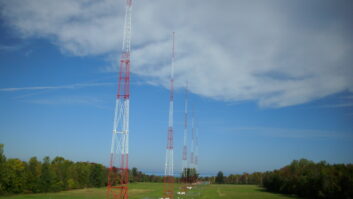Now That NRSC-5 Is in the FCC’s Hands, What Happens Next for Digital Radio Regulation?
The FCC has been in receipt of NRSC-5, the IBOC standard, for a while now, so focus of the industry has shifted the commission’s way, awaiting the next steps on digital radio regulations. One of the key external elements the FCC was anticipating prior to moving forward on IBOC rules was NRSC-5. Now that this has been delivered, will final IBOC rules be forthcoming, or will further interim steps be required?
First let’s consider what NRSC-5 contains, or more importantly, what it doesn’t contain.
Several important items are not included in the standard. First, there is no audio codec specified for IBOC, and no method delineated by which a transmission can specify any particular codec(s) in use on the channel. Second, there are no specifications for IBOC datacasting in the standard – although the NRSC is continuing work in this area, and a datacasting update to the standard might be forthcoming at some point in the future.
What NRSC-5 does specify with substantial completeness is the IBOC AM and FM transmission systems, without saying much about the content transmitted therein.
Thus, the first major regulatory question is: Does NRSC-5 provide enough detail for the FCC to move forward with development of final IBOC rules based solely upon the standard; or will the commission have to do additional work of its own before reaching an adequate level of specification for such work?
Specifically, how will the FCC handle the codec issue? Certainly the standard provides plenty to work from, but its omissions are not negligible, and these gaps may require substantial staff effort from the FCC to fill.
Process-wise, a number of options are possible, from soliciting comment on NRSC-5 via Public Notice, to issuing another FNPRM, to moving straight to R&O. It will be interesting to see how the FCC chooses to proceed under these unusual circumstances.
Content protection, anyone?
Another open question regards what if any next action the FCC will take in the area of digital radio content protection. You may recall that along with its last FNPRM on digital radio, the commission issued an NOI on content protection. The RIAA filed voluminous comments to this inquiry, advocating the establishment of a system akin to the “Broadcast Flag” (the content-protection system proposed for use in ATSC digital television).
Most other commenters disagreed; and meanwhile the courts have invalidated the DTV Broadcast Flag rules on the grounds that the FCC has no jurisdiction over how receivers handle broadcast content once the signal is demodulated, unless explicitly given such authority by Congress. Moves are underway to have Congress grant the FCC this authority for content protection rules, but the outcome here is also decidedly uncertain at press time.
On the other hand, if a new content protection solution is devised in the DTV environment, this approach might find its way into IBOC as well. So again, the commission may be forced to wait for external developments before closing a key digital radio topic.
Wait, there’s more
The list of unsettled second-tier issues for IBOC regulation is also lengthy. It includes AM nighttime operation, dual-antenna transmission for FM, Supplemental Audio Services rules, an emission designator for IBOC, FM-IBOC translator rules and more. Some of these items certainly will be addressed in the FCC’s next regulatory step for IBOC, but some may remain open.
A few other interesting issues in this area have been raised recently, one in this publication’s April 27 issue. In a Guest Commentary, broadcast attorney John Garziglia calls for rules requiring all satellite radio receivers to include IBOC AM and FM capabilities. This is not unprecedented; the FCC’s rules for new digital cable-ready receivers include a phase-in requirement for inclusion of ATSC terrestrial broadcast DTV tuners, for example.
To date, the satellite radio industry has voluntarily included analog AM/FM tuners in all their receivers, of course. This simply made good sense for the primary automotive market, where the idea of multiple radios was impractical and unwelcome. It also is good business during any transitional phase to combine support for both legacy and emergent formats in any new products. But this voluntary integration may not last forever, and there is likely to be significant push-back from the satellite radio industry to any move that would mandate inclusion of terrestrial receivers, even analog, but especially IBOC.
This would not be purely an issue of cost. Consider that the audio quality of satellite radio is fairly similar to that of analog radio. In fact, on a good reproduction system, FM analog terrestrial audio sounds noticeably better than satellite radio services, especially for voice-only channels. (Voice services on satellite radio are more akin to AM radio quality.) Nevertheless, satellite radio does not suffer from the impulse noise of terrestrial AM, nor the multipath distortion of FM, so on balance, quality issues are probably a wash between satellite and terrestrial analog radio. Add IBOC to this equation, however, and the balance could shift substantially in terrestrial radio’s favor, with both music and voice services sounding substantially better on terrestrial than on satellite radio. Thus an attempt to require IBOC reception capability in satellite radios is likely to face a pitched battle.
Any discussion of new radio regulations might also include the issue of “podjacking,” as well. There is a growing number of reports from automotive listeners that when they pull up to a traffic light at a multilane intersection, the FM station they were listening to is momentarily interfered with, if not overtaken by the adjacent car’s iPod FM modulator accessory. Consider that in some cases, the iPod modultor’s antenna may actually be closer to the adjacent car’s receive antenna than it is to its own (e.g., iPod on the passenger seat, radio antenna on the rear deck, adjacent car one lane to the right with its radio antenna on the left side). Further, some of these devices only offer frequencies at the lower end of the FM band, meaning that NCE stations bear the brunt of the problem.
On the other hand, other users report that they cannot maintain a consistent signal from their iPod as they drive around town, due to the inability to find an FM frequency that is consistently vacant enough to not interfere with their iPod signal. So there is pressure to increase the output power of these modulator accessories. Thus the FCC may be forced to react to the podjacking issue in upcoming rulemakings, as well.
Whatever happens, radio will be squarely on the FCC’s agenda in the near future. The new population of the commission makes this an even more interesting scenario for commission watchers. Stay tuned.










